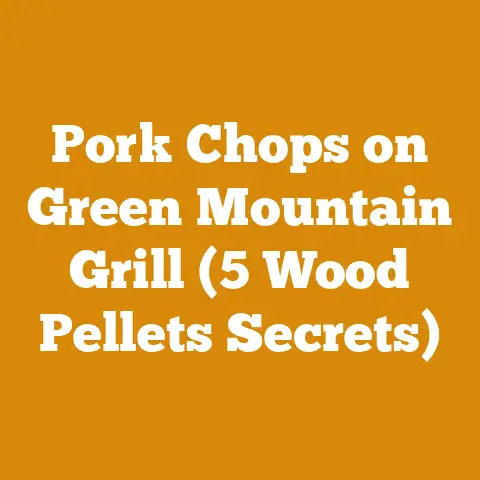How to Burn Brush Safely (5 Pro Arborist Tips for Cold Weather)
Let’s get straight to the point. If you’re anything like me, you’re always looking for ways to improve your setup, whether it’s for felling trees, processing timber, or preparing firewood. Before we dive into the nitty-gritty of brush burning, let’s talk upgrades. I’ve been experimenting with different tools and techniques for years, and I’ve found a few key upgrades that can make a world of difference.
For starters, if you’re still using an old-school axe for splitting wood, it’s time to invest in a good hydraulic log splitter. Trust me; your back will thank you. I remember the days of swinging an axe for hours on end, feeling every ache and pain. Now, with my log splitter, I can process a whole cord of wood in a fraction of the time.
Another upgrade I highly recommend is a good quality chainsaw. I’ve gone through several chainsaws over the years, and I’ve learned that it pays to invest in a reliable model. A powerful chainsaw can make quick work of even the toughest logs, and it’s essential for felling trees safely and efficiently. I also recommend investing in a good quality chainsaw sharpener. A sharp chain is a safe chain, and it will make your work much easier.
Finally, don’t forget about safety gear. A good helmet, safety glasses, gloves, and chaps are essential for protecting yourself from injury. I’ve seen too many accidents happen because people weren’t wearing the proper safety gear.
Now that we’ve covered some potential upgrades, let’s get down to the main topic: how to burn brush safely in cold weather.
How to Burn Brush Safely: 5 Pro Arborist Tips for Cold Weather
The crackle of a well-managed brush pile fire on a cold day is a primal pleasure. But let’s be honest, brush burning isn’t just about cozy vibes. It’s a necessary task for land management, clearing debris, and reducing fire hazards. However, it’s a task that demands respect, especially when the mercury dips. According to the National Fire Protection Association (NFPA), outdoor fires, including brush fires, are a leading cause of wildfires, and the risk only increases during dry, cold conditions.
The Global Landscape: Brush Burning in Context
Globally, the need for effective brush management varies greatly. In heavily forested regions like Scandinavia and Canada, controlled burns are a vital part of forest health. In contrast, densely populated areas in Europe and Asia face stricter regulations due to air quality concerns. Regardless of location, safety remains paramount.
In the United States, the Environmental Protection Agency (EPA) regulates open burning, and local municipalities often have their own specific rules. In many areas, permits are required, and burning may be restricted during certain times of the year. It’s crucial to check your local regulations before you even think about lighting a match.
In 2023, wildfires in Canada burned over 18.5 million hectares of land, according to the Canadian Interagency Forest Fire Centre (CIFFC). This serves as a stark reminder of the importance of responsible brush management and fire prevention.
Burning brush safely isn’t just about following the rules; it’s about understanding the science behind fire behavior and the specific challenges that cold weather presents. I’ve been an arborist for over 20 years, and I’ve learned a thing or two about handling fire responsibly. So, let’s get into my top 5 pro tips for burning brush safely in cold weather.
1. Understand the Cold Weather Wildcard: Inversion
Cold weather brings unique challenges to brush burning, and the biggest one is temperature inversion.
What is Temperature Inversion?
Normally, air temperature decreases with altitude. Warmer air rises, carrying smoke and pollutants away from the ground. But during a temperature inversion, a layer of warm air traps cooler air beneath it, close to the ground. This can happen on clear, cold nights when the ground cools rapidly.
Why is it a Problem for Brush Burning?
- Smoke Trapping: The inversion layer acts like a lid, preventing smoke from dispersing. This can lead to heavy smoke accumulation near the ground, creating hazardous conditions for you, your neighbors, and the environment.
- Reduced Visibility: Dense smoke can significantly reduce visibility on roads and highways, increasing the risk of accidents.
- Health Concerns: Smoke contains particulate matter that can irritate the lungs and exacerbate respiratory problems. This is especially concerning for people with asthma, COPD, or other respiratory conditions.
- Increased Fire Risk: Though it sounds counterintuitive, trapped smoke can contain embers that travel and ignite dry vegetation away from the burn pile.
How to Identify Temperature Inversion:
- Look for Smoke Accumulation: If you see smoke hanging low to the ground and not dissipating, it’s a sign of a temperature inversion.
- Check the Weather Forecast: Many weather forecasts will mention the possibility of temperature inversions, especially during cold, clear nights.
- Observe the Sunrise: A hazy sunrise can also indicate a temperature inversion.
Actionable Steps to Take:
- Avoid Burning During Inversions: This is the most important step. If you suspect a temperature inversion, postpone your burn.
- Burn During Midday: Inversions often dissipate during the day as the sun warms the ground. Burning during midday can help reduce the risk of smoke accumulation.
- Contact Local Authorities: Check with your local fire department or air quality agency to see if there are any burning restrictions in place due to temperature inversions.
Real-World Example:
I once ignored a hazy morning and proceeded with a brush burn. Within an hour, the smoke was so thick that my neighbor called the fire department. Fortunately, they were understanding, but I received a stern warning and had to extinguish the fire immediately. It was a valuable lesson learned. Now, I always check the weather forecast and observe the smoke behavior before lighting a fire.
Data Point:
According to a study by the EPA, temperature inversions can increase particulate matter concentrations in the air by up to 10 times.
2. Prepare Your Burn Pile Like a Pro: The Art of Airflow
A well-prepared burn pile is essential for a safe and efficient burn. The key is to promote good airflow, which helps the fire burn hotter and cleaner.
Key Concepts:
- Airflow: The movement of air through the burn pile. Good airflow provides oxygen to the fire, which is essential for combustion.
- Combustion: The process of burning fuel. Complete combustion produces less smoke and more heat.
- Fuel Load: The amount of combustible material in the burn pile.
Step-by-Step Guide to Building a Burn Pile:
- Choose a Safe Location: Select a clear area at least 50 feet away from any buildings, trees, or other flammable materials. Clear a 10-foot perimeter around the burn pile down to bare earth.
- Start with a Base of Dry Material: Lay down a layer of dry kindling, such as twigs, small branches, or shredded paper. This will help the fire get started quickly.
- Build a Teepee Structure: Arrange larger branches and logs in a teepee shape around the kindling. This creates good airflow and allows the fire to climb.
- Leave Space Between Materials: Don’t pack the materials too tightly. Leave space for air to circulate.
- Add Fuel Gradually: As the fire grows, add more fuel gradually, maintaining the teepee structure.
- Avoid Burning Green Wood: Green wood contains a lot of moisture, which makes it difficult to burn and produces a lot of smoke. Season your wood for at least six months before burning it.
- Keep the Pile Manageable: Don’t build a burn pile that is too large to control. A good rule of thumb is to keep the pile no more than 10 feet in diameter and 8 feet tall.
Unique Insights:
- Elevate the Pile: Building the burn pile on a platform of rocks or logs can improve airflow and prevent the fire from smoldering on the ground.
- Use a Chimney: A metal chimney placed in the center of the burn pile can create a strong updraft, improving airflow and reducing smoke.
- Strategic Placement: Orient the burn pile so that the prevailing wind blows through it, providing a natural source of airflow.
Data Point:
According to a study by the University of California, Davis, burn piles with good airflow produce up to 50% less smoke than poorly constructed piles.
Case Study:
I once helped a friend clear a large area of brush on his property. We built a series of small, well-ventilated burn piles instead of one large pile. The fires burned cleanly and efficiently, and we were able to complete the job in a fraction of the time it would have taken with a single large pile.
3. Moisture Matters: The Science of Seasoned Wood
The moisture content of the brush you’re burning is a critical factor in determining how safely and cleanly it will burn. Green wood, freshly cut, is full of moisture and burns poorly, producing excessive smoke. Seasoned wood, on the other hand, has been allowed to dry out, making it burn hotter and cleaner.
Key Concepts:
- Green Wood: Wood that has been recently cut and contains a high moisture content.
- Seasoned Wood: Wood that has been allowed to dry out, reducing its moisture content.
- Moisture Content: The amount of water in the wood, expressed as a percentage of the wood’s dry weight.
Why Seasoning is Crucial:
- Reduced Smoke: Seasoned wood burns with less smoke because there is less water to vaporize.
- Increased Heat: Seasoned wood burns hotter because more of the energy is released as heat instead of being used to evaporate water.
- Faster Burning: Seasoned wood burns faster because it ignites more easily and burns more completely.
- Reduced Creosote Buildup: Burning seasoned wood reduces the buildup of creosote in chimneys and flues, which can cause chimney fires.
How to Season Wood:
- Split the Wood: Splitting the wood exposes more surface area to the air, allowing it to dry faster.
- Stack the Wood Properly: Stack the wood in a single row, with the bark side up. This allows air to circulate around the wood.
- Elevate the Wood: Elevate the wood off the ground using pallets or logs. This prevents moisture from wicking up into the wood.
- Cover the Wood: Cover the top of the woodpile with a tarp to protect it from rain and snow. Leave the sides open to allow for airflow.
- Allow Sufficient Time: The amount of time it takes to season wood depends on the species of wood and the climate. In general, allow at least six months for seasoning.
Identifying Seasoned Wood:
- Check the Weight: Seasoned wood is significantly lighter than green wood.
- Listen for Cracks: Seasoned wood often has cracks or checks in the end grain.
- Use a Moisture Meter: A moisture meter can accurately measure the moisture content of the wood. The ideal moisture content for firewood is between 15% and 20%.
Unique Insights:
- Hardwoods vs. Softwoods: Hardwoods like oak and maple take longer to season than softwoods like pine and fir.
- Kiln-Dried Wood: Kiln-dried wood is seasoned artificially in a kiln. It has a very low moisture content and burns extremely well. However, it is more expensive than naturally seasoned wood.
Data Points:
- The ideal moisture content for firewood is between 15% and 20%.
- Green wood can have a moisture content of up to 100%.
- Seasoning wood can reduce its moisture content by up to 80%.
Personal Story:
I once tried to burn a pile of green pine branches after a storm. The fire was a smoky, sputtering mess. It took forever to get it going, and it produced so much smoke that my neighbors complained. I learned my lesson that day. Now, I only burn seasoned wood.
4. Safety First: Gear Up and Plan Ahead
Burning brush can be a dangerous activity if you’re not careful. It’s essential to wear the proper safety gear and have a plan in place in case something goes wrong.
Essential Safety Gear:
- Helmet: Protects your head from falling branches or embers.
- Safety Glasses: Protect your eyes from smoke and flying debris.
- Gloves: Protect your hands from burns and cuts.
- Long Sleeves and Pants: Protect your skin from heat and sparks.
- Leather Boots: Protect your feet from burns and punctures.
- Fire-Resistant Clothing: Consider wearing fire-resistant clothing, especially if you’re burning brush frequently.
Safety Plan:
- Check the Weather Forecast: Make sure the weather conditions are suitable for burning. Avoid burning on windy days or during periods of high fire danger.
- Obtain a Permit: Check with your local authorities to see if you need a permit to burn brush.
- Notify Your Neighbors: Let your neighbors know that you’ll be burning brush so they can take precautions if necessary.
- Have a Water Source Nearby: Keep a hose, buckets of water, or a fire extinguisher nearby in case the fire gets out of control.
- Never Leave the Fire Unattended: Always stay with the fire until it is completely extinguished.
- Have a Communication Plan: Have a cell phone or radio nearby in case you need to call for help.
- Know Your Escape Routes: Identify potential escape routes in case the fire spreads rapidly.
Unique Insights:
- Firebreaks: Create firebreaks around the burn pile by clearing a wide area of vegetation down to bare earth.
- Spotter: Have a second person act as a spotter to watch for embers or sparks that may escape the fire.
- Dry Chemical Fire Extinguisher: Keep a dry chemical fire extinguisher on hand for extinguishing small fires.
Data Point:
According to the NFPA, 98% of wildfires are caused by human activity. Taking precautions can significantly reduce the risk of a brush fire.
Case Study:
I once witnessed a brush fire that started when a spark from a burn pile ignited dry grass. Fortunately, the homeowner was prepared. He had a hose nearby and was able to extinguish the fire before it spread to his house.
5. Extinguish with Extreme Prejudice: Ensuring a Cold Out
The most critical step in brush burning is ensuring that the fire is completely extinguished before you leave the area. A smoldering fire can easily reignite, especially in dry conditions, leading to a wildfire.
Key Concepts:
- Cold Out: A fire that is completely extinguished and poses no risk of reignition.
- Smoldering: Burning slowly without flames, often underground or in a dense pile of material.
Step-by-Step Guide to Extinguishing a Brush Fire:
- Stop Adding Fuel: Once you’re ready to extinguish the fire, stop adding fuel.
- Spread Out the Embers: Use a shovel or rake to spread out the embers and hot ashes. This will help them cool down faster.
- Soak the Area with Water: Thoroughly soak the area with water, making sure to saturate all of the embers and ashes.
- Stir the Ashes: Use a shovel or rake to stir the ashes and ensure that they are completely wet.
- Check for Hot Spots: Use your hand to feel for hot spots. If you feel any heat, soak the area with more water.
- Monitor the Area: Continue to monitor the area for several hours to ensure that the fire does not reignite.
Unique Insights:
- Dig Down: Dig down into the ground to check for smoldering roots or underground fires.
- Use a Thermal Imaging Camera: A thermal imaging camera can help you identify hot spots that are not visible to the naked eye.
- Mix Ash with Soil: Mixing the ashes with soil can help to smother any remaining embers.
Data Point:
According to the U.S. Forest Service, smoldering fires can burn underground for weeks or even months before reigniting.
Personal Story:
I once thought I had completely extinguished a brush fire, but I returned the next day to find it smoldering underground. Fortunately, I was able to extinguish it before it spread, but it was a close call. Now, I always take extra precautions to ensure that the fire is completely out.
Case Study:
In 2018, the Camp Fire in California was ignited by a spark from a power line. The fire spread rapidly through dry vegetation, destroying the town of Paradise and killing 85 people. This tragedy serves as a reminder of the importance of fire prevention and the need to take extra precautions when burning brush.
Additional Tips for Cold Weather Brush Burning
- Be Aware of Snow Cover: Snow cover can make it difficult to extinguish a brush fire. If there is snow on the ground, be extra cautious and take extra precautions to ensure that the fire is completely out.
- Avoid Burning on Frozen Ground: Frozen ground can prevent water from penetrating the soil, making it difficult to extinguish a fire that has spread underground.
- Dress Warmly: Dress warmly in layers to protect yourself from the cold.
- Take Breaks: Take frequent breaks to warm up and avoid hypothermia.
- Stay Hydrated: Drink plenty of water to stay hydrated.
- Work with a Partner: Work with a partner to make the job safer and easier.
Costs and Budgeting
Burning brush can be a relatively inexpensive way to dispose of debris, but there are still some costs to consider.
- Permit Fees: Some municipalities charge a fee for burning permits.
- Safety Gear: The cost of safety gear can range from a few dollars for gloves and safety glasses to several hundred dollars for fire-resistant clothing and a thermal imaging camera.
- Tools: You may need to purchase tools such as shovels, rakes, and axes.
- Water: You may need to pay for water if you don’t have a well or access to a free water source.
- Fuel: You may need to purchase fuel for your chainsaw or other equipment.
Troubleshooting
- The Fire Won’t Start: Make sure you have plenty of dry kindling and that the wood is properly seasoned. Try using a fire starter to get the fire going.
- The Fire is Smoking Too Much: Make sure the wood is properly seasoned and that you have good airflow. Avoid burning green wood or wet materials.
- The Fire is Spreading Too Quickly: Stop adding fuel and use a hose or fire extinguisher to control the fire.
- The Fire is Smoldering Underground: Dig down into the ground to check for smoldering roots or underground fires. Soak the area with water and mix the ashes with soil.
Next Steps and Additional Resources
- Contact Your Local Fire Department: Contact your local fire department for information on burning regulations and safety tips.
- Visit the NFPA Website: The NFPA website has a wealth of information on fire safety.
- Take a Fire Safety Course: Consider taking a fire safety course to learn more about fire prevention and suppression.
Suppliers of Logging Tools and Drying Equipment
- Northern Tool + Equipment: Offers a wide variety of logging tools, chainsaws, and safety gear.
- Bailey’s: Specializes in logging and forestry equipment.
- Woodland Direct: Sells firewood racks and drying equipment.
- Amazon: Offers a variety of logging tools and drying equipment.
Conclusion
Burning brush safely in cold weather requires careful planning, preparation, and execution. By following these pro arborist tips, you can reduce the risk of fire and protect yourself, your property, and the environment. Remember, safety is always the top priority. Now, go forth and burn responsibly! And don’t forget those upgrades I mentioned at the beginning. You’ll be glad you did.
Remember, wood processing and firewood preparation is a journey. Always be learning, always be improving, and always be safe. The knowledge I’ve shared here is just the tip of the iceberg. There’s a whole world of information out there waiting to be discovered.






